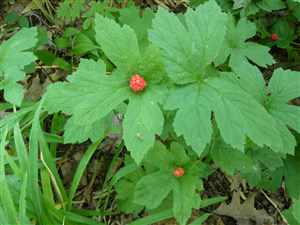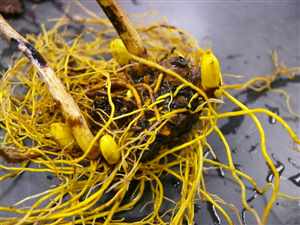Goldenseal (Hydrastis Canadensis)
Main Facts about Goldenseal

Goldenseal is a small, 6-12 inches tall, erect perennial with a hairy, purplish stem and short, knotty rhizome with yellow-brown bark and bright yellow pulp. The plant has deeply toothed leaves and red, raspberry-like berries with two shiny black seeds inside.
Parts used – rhizomes and roots.
Goldenseal is named for its rhizome’s characteristic yellow color, and it was popular among Native Americans as both a dye and a medicine.
They used it as a remedy for a wide range of conditions: skin inflammations, digestive problems, and ailments of the eye, ear, lung, heart, and liver.
Goldenseal quickly became a popular home remedy among European settlers, as well. Over time, Goldenseal acquired some of Ginseng’s medicinal reputation as a panacea and longevity tonic, hence another of its popular names, “poor man’s ginseng”.
Goldenseal’s popularity led to the overharvesting of the wild plants. Today this species is considered endangered. Goldenseal remains one of the top-selling botanical products sold by the health-food industry, and some commercial suppliers now cultivate it.
Using Goldenseal

It is prescribed internally for diarrhea and colds, respiratory infections, eye infections and (as a mouthwash) sore gums and throats. It is used as a douche for vaginal infections and to stop excessive menstrual flow and postpartum uterine bleeding.
In addition to killing bacteria, some research shows that berberine boosts the immune system.
It is recommended externally as an antiseptic to clean wounds and as a treatment for eczema, ringworm, athlete’s foot, itching, and conjunctivitis. Commercially prepared Goldenseal salves and ointments (sometimes blended with Comfrey or Plantain) are available for treating sores, cuts, and other skin irritations.
There is no evidence that Goldenseal is effective against the viruses that cause colds and flu. In folk tradition Goldenseal was used almost exclusively as an oral treatment for digestive tract infections or topically for bacterial and fungal infections. Modern research confirms these benefits, but Goldenseal will not shorten the duration of cold and flu.
Take 1 to 2 drops of the tincture of 1 to 2 capsules twice daily. Or drink 1 cup of the tea up to 3 times daily. Use ½ to 1 tsp of powdered root per cup of boiling water, steep for 10 min, and strain. Goldenseal tastes bitter, add honey, sugar, or lemon to improve the flavor.
Goldenseal is a remedy for: Cold and flu
How to grow Goldenseal
Goldenseal is difficult to cultivate in a garden. It requires rich, moist, well-drained soil in part to full shade. It grows best under tree cover or shade frames. Plants may be started from seeds, but it takes 5 years for the roots to become medicinally beneficial. It is recommended to buy 2-year-old rhizomes from specialty suppliers. Rhizomes should have a sweet, licorice-like aroma.
Plant them in early fall at a depth of 1 inch with 8-inch spacing in soil enriched with compost, leaf mold, sand, and bone meal. In winter, mulch with shredded leaves. Frequently, top growth will not appear until the second summer.

| Ginseng |
Gotu kola
|